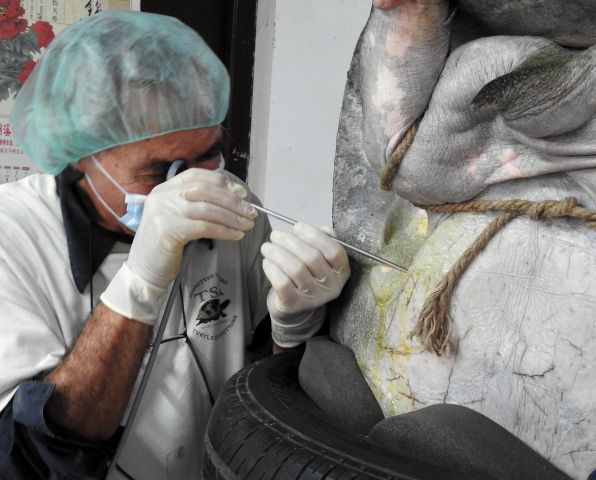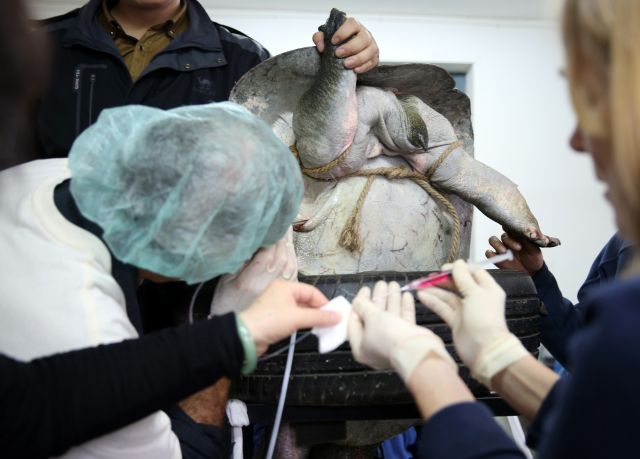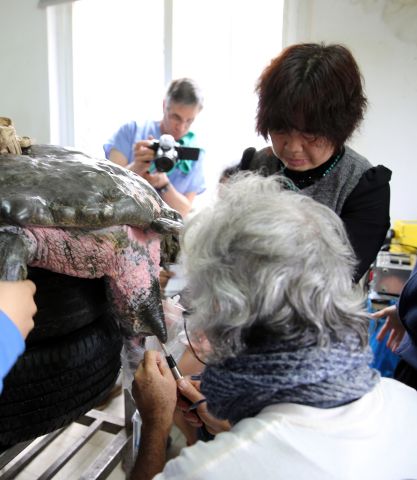Ground breaking procedure gives new hope for the survival of Rafetus

by Howard Goldstein, Rick Hudson and Paul Calle
On April 7, 2016 Dr. Gerald Kuchling (TSA) performed for the first time that we know of a surgical artificial insemination (AI) procedure on a reptile. This innovative procedure was a historic attempt to save the world's most critically endangered turtle, the Yangtze Giant Softshell (Rafetus swinhoei).
The team of researchers lead by Dr. Kuchling and Dr. Lu Shunqing from Wildlife Conservation Society's (WCS) China program, working with Suzhou Zoo's Dir. Chen Daqing, Di Min, Tang Enen, Tang Deqi, Chen Jing Han Shichang, Liu Xing Feng Qi, and Lu Fang and Changsha Zoo's Dir Yan Xiahui and Yang Junlong and veterinarians from the Changsha and Suzhou Zoos (Drs. Lu Qingtao and Sun Ai Guos from the Changsha and Suzhou Zoo, respectively), Dr. Barbara Durrant of San Diego Zoo's Center for Conservation Research, Emily King (TSA), and Dr. Paul P. Calle (WCS), and Liu Nonglin (China Zoo Society), performed the world's first artificial insemination of a softshell turtle species at the Suzhou Zoo in Suzhou, China in May 2015. This was a ground breaking attempt both in performing this procedure and in saving the world's most critically endangered turtle. At the time, the global population of R. swinhoeiconsisted of four individuals; a female from the Changsha Zoo that was paired with a male at the Suzhou Zoo in China, and two males in separate locations in Vietnam. Poised on the knife-edge of extinction, the stakes, it seemed, could not get higher; and then they did, when one of the males in Vietnam died in January 2016. As of this writing, there are only three known Yangtze Giant softshell turtles left on Earth.
Unfortunately, the first AI attempt in May 2015 did not succeed and none of the female's eggs were fertile. But that didn't stop the battle to save R. swinhoei.

Committed to TSA's mantra of zero turtle extinctions, Dr. Kuchling again led the team that once again made conservation history last month. Last year, AI was attempted by introducing semen into the female's cloaca; this time, the male's semen was surgically injected directly into the female's oviducts, thus bypassing the complications of getting through the cloaca into the oviduct.
It was a radical approach for a dire situation: the last female Yangtze Giant Softshell turtle must produce a viable clutch of eggs if the species is not to die with her. Upon its successful completion last month, hopes are again high that we may be able to save this species.
Once abundant in the Yangtze and Red river systems of China into northern Vietnam, massive habitat destruction, overharvest, and pollution brought the Yangtze Giant Softshell to the brink of extinction by the 1990s.
The ongoing attempt to rescue R. swinhoei from extinction has arguably been amongst the most dramatic and problematic in conservation history, with every new success seemingly meeting a newer challenge.
Initially, the species was considered possibly extinct until the few above mentioned animals were discovered in the Suzhou and Changsha Zoos, in China; in addition two specimens were known from Vietnam. Among the (then) four known living individuals, only one, a nearly 100-year-old animal held at the Changsha Zoo, was female.

In 2008, the TSA coordinated the movement of this female to Suzhou to pair with the male. Despite mating behavior being observed, and over a thousand eggs laid over an eight year time span, she never produced a fertile clutch of eggs. The optimism of the early years when hopes for a successful breeding ran high, eventually gave way to disappointment with each successive year's reproductive failure. Donor fatigue set in as well, and funds to support the project began to dry up. Fortunately one organization, the Kadoorie Farm and Botanic Garden in Hong Kong, did not give up and continued to direct funds through the TSA to support this work.
In 2015 closer examination of the male under anesthesia revealed the reason for the infertile eggs: his penis was horribly mangled and scarred, preventing effective copulation. Female softshell turtles have an intricately labyrinthine cloaca, with males of each species equipped with a similarly bizarre penis designed to fit like a key in a lock. Prior to the arrival of the Changsha Zoo female, the Suzhou Zoo male had once been kept with another adult male. Yangtze Giant Softshells are aggressive, territorial animals and the two males fought one another viciously, culminating in the death of the other male and perhaps this fight resulted in significant damage to the penis of the survivor. In May 2015,with the extinction clock ticking down on R. swinhoei, the decision to try AI—a procedure rarely performed but never successfully on any turtle species—was made. Semen was collected from the anesthetized male by electro ejaculation, and insemination performed via the cloaca.
The first AI attempt, using cloacoscopy for insemination, likely failed for two reasons: relatively low sperm density and poor sperm motility; and the complex cloacal structure that proved a difficult gauntlet for the already compromised sperm.
Electroejaculation under anesthesia was performed again in October 2015, but AI was not possible due to inadequate semen quantity.
But with failure not an option, another AI attempt was scheduled for early April 2016.
A week before the surgery was performed in China, the project's lead biologist Dr. Kuchling, and Dr. Calle visited Omaha's Henry Doorly Zoo (HDZ), to work with their staff to perform cloaccal examinations of two species of softshell turtles in their zoo collection. It was here that Dr. Kuchling made the determination that coeloscopy, a surgical approach through the body cavity for surgical insemination directly into the oviducts, was a better option than the previously attempted cloaccal route. The TSA is especially grateful to Jessi Krebs and Sara Plesuk (HDZ) for facilitating this important research and allowing us access to their collection.
The male was again anesthetized for AI by Drs. Lu Qingtao, Sun Ai Guos, and Calle for electro ejaculation, and the female for the surgery, a challenging task given the turtle's age. Dr. Kuchling, assisted by Drs. Durant and Shunqing, performed the procedure. "Our expectations are higher now than they have been in years" said TSA President Rick Hudson. "This team's willingness to innovate and push the envelope has us in the best position we could possibly hope for, given the hand that we have been dealt,"
Dr. Kuchling explains the procedure: "I inserted a long needle directly into the lumen of both oviducts (one after the other) and Barbara [Durrant] injected the semen. All went well, even though the female was anesthetized for over two hours. It was the longest and most challenging endoscopic procedure I ever did."
In addition to this procedure delivering the sperm closer to the fertilization site of ova following ovulation, there is yet another reason for optimism. This sperm sample was better quality, with higher sperm counts and density, than in the previous cloaccal attempt. Despite the previous unsuccessful attempt in May 2015, microscopy revealed that although no eggs were fertilized, some sperm did manage to attach to the outer egg membrane. A much better sample of semen, injected directly into the oviducts, is likely to greatly increase the sperms' chances to fertilize an egg. And Kuchling reports that the 46 kg female had massively expanded ovaries filled with over 200 ova.
Of course, the congested body cavity also complicated an already delicate procedure, as the needle had to be injected into the horns of the oviducts without puncturing the follicles or the adjacent bladder.
Fortunately the surgery was a success, and the team has no doubt that, to date, it represents the very best chance of fertilizing the female and saving Rafetus swinhoei. The world will know for sure when she lays within the next few weeks.
"Given the higher sperm density and direct injection into the oviducts," said Dr. Kuchling, "I am now more confident than I was last year that we may get lucky and get some fertile eggs."
Photo Credit, middle and bottom images: Di Min (Suzhou Zoo)
